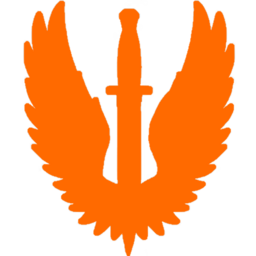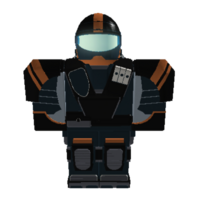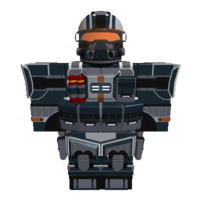Spec Ops
| Spec Ops |
|---|

|
| Department: Spec Ops |
| Rooms: Shuttle Bay |
| Guides: Guide to Roleplaying, Ranks |
| Ranks: Petty Officer 1st Class (E-6), Chief Petty Officer (E-7), Senior Chief Petty Officer (E-8), Master Chief Petty Officer (E-9) |
 |
 |
The Sol Defense Corps Naval Special Operations Command (NAVSOC), commonly known as Spec Ops, is the SDC Navy's primary special operations force. They are charged with the assassination, capture and surveillance of high-valued enemy targets, or are tasked with protecting and defending allied VIP personnel. They additionally assist in intelligence gathering and regularly partner with the Sol Intelligence Service to gather data.
NAVSOC personnel consist of highly elite, trained soldiers and take part in rigorous training exercises to be experts at precise, unconventional warfare. They are armed with specially-modified SDC weaponry and are capable of carrying out highly dangerous missions even the elite Marines can't manage by themselves.
As of 2114, there are approximately 10,450 active-duty Spec Ops soldiers, 91% male and 8% female. All enlisted Spec Ops personnel are rated at Petty Officer 1st Class (E-6) or higher.
Spec Ops soldiers are led in platoons by a Spec Ops Officer, a commissioned NAVSOC officer with command training in addition to the training phase listed below.
Duties and Abilities[edit | edit source]
Spec Ops soldiers are able to perform elite activities in the name of special and unconventional warfare, capable of covert assassinations, intelligence gathering, or asset protection. Certain Spec Ops soldiers are specially trained to handle, protect, and defend high-risk allied persons such as political figures or high-ranking military officials.
Spec Ops are trained in marksmanship, close combat, hostile environment training, martial arts and demolitions. They are equipped with one of two Spec Ops combat-rated hardsuits capable of withstanding medium to heavy arms fire, with shock absorbers and ablative plating allowing for the suit to double as survival gear.
Entrance into the Spec Ops program is elite, and very few can proudly take the mantle.
Training[edit | edit source]
Spec Ops soldiers undergo a highly elite and rigorous training program with a graduation rate of around 6% of all applicants. Merely being qualified for the NAVSOC training program is a feat in itself, and dropping out of the program or failing the course is rarely taken as defeat - merely a mild setback. Keeping with the US Navy's tradition, candidates who wish to drop out of the Spec Ops training program only need to ring a bell to exit the course silently and without drawbacks or repercussions.
Physical Training[edit | edit source]
Training consists of several courses undertook over the course of more than a year. The 8-week NAVSOC Preparatory Training (SOCPT) educates applicants on the basics of Spec Ops development as well as undergoing a heavy screening process to determine which candidates are the most capable.
Physical training requirements include having applicants be able to:
- Run up to 10 kilometers (6.2 miles) in PT wear,
- Run up to 5 kilometers (3.1 miles) in a Special Operations Combat hardsuit,
- Carry up to 30 kilograms of payload (approximately the felt weight of a combat hardsuit with exoskeleton assist), and
- Withstand G-Forces of up to 3G sustained for 5 minutes.
Applicants in SOCPT are given their first 7 weeks of the course to train for the aforementioned requirements. Groundside training is held for the first 4 weeks at SDB Gibraltar, then for the final 3 weeks (including the tests) on SDCSS Constellation in Earth orbit. Applicants have space and microgravity training on the Constellation before being tested through the starbase's dedicated Special Training wing.
Basic Combat Training[edit | edit source]
Applicants who pass SOCPT graduate to the Combat phase of training, known as the NAVSOC Warfare Training (WARTRAIN) program. Applicants are taught how to use their combat hardsuits to their full potential, including usage of its armor, RCS and maneuvering capabilities, its exoskeleton, and various other features.
Applicants are accustomed to the suits in microgravity and are ordered to perform several basic tests, including maneuvering from one point to another. Firearm handling courses follow shortly afterward, giving applicants standard-issue rifles in Spec ps usage such as the M7S4 and DMR-225, with dummy ammunition. Applicants learn how to handle the firearms and are given marksmanship training both with and without gravity, also receiving training on how to clean, maintain, and handle a weapon in microgravity. Live fire exercises are carried out afterward on the ground, training applicants on the limitations and capabilities of armor-piercing, FMJ and hollow-point ammunition when used on spacecraft.
This phase lasts for 8 weeks.
Drop and Survival School[edit | edit source]
Spec Ops applicants then move onto the third stage of training, known as Drop and Survival School (DASS), where they undergo education and training in dropping to the surface. This covers the following methods of air-to-surface insertion:
- Parachuting
- Landing via dropship
- Jetting to the surface (via suit thrusters)
- Drop pods
Spec Ops must know how to operate and safely land using all aforementioned methods.
DASS also educates soldiers on survival tactics using said methods, including education on drop pods' survival kits, emergency situations such as a parachute or thruster failure, and surviving a crashing dropship. Particularly risky and lethal scenarios are carried out using virtual reality, ensuring applicants are trained in any possible scenario.
This phase lasts 6 weeks.
Hostile Environment Training[edit | edit source]
Spec Ops are trained in the same hostile environment scenarios as Marines, being educated on how to operate, navigate and survive in hostile planetary environments such as that of Mars, Venus, Luna, and Io. Applicants are schooled on the environmental risks that each planet provides, and gives strategies and training to combat or nullify several hazards. This phase lasts 6 weeks.
Advanced Combat Training[edit | edit source]
After being taught how to use weaponry in conventional manners, applicants move to Advanced Combat Training (ACT), where unconventional weapons and tactics are used, such as melee weapons (blunt, bladed, thermal), close-quarters combat (CQC), demolitions, room clearing, martial arts, medical skills, and advanced marksmanship and weapons training. This phase puts Spec Ops soldiers through the hardest and final phase of Spec Ops training before graduating.
This phase lasts 9 weeks, after which Spec Ops soldiers are assigned to one of 20 teams and undergo occupational training in each team, such as marksmanship courses.
| |||||||||||||||||||||||||||||||||||||||||
